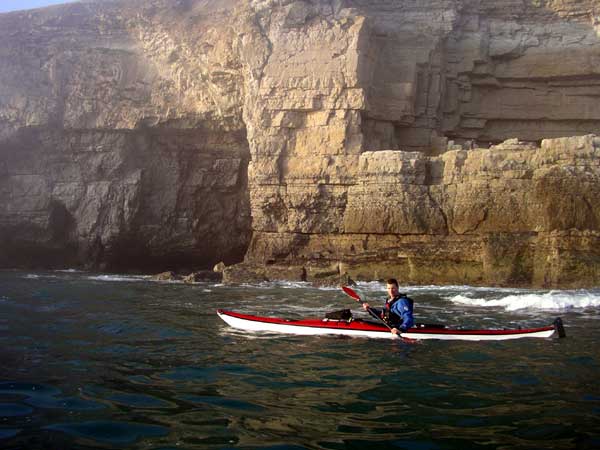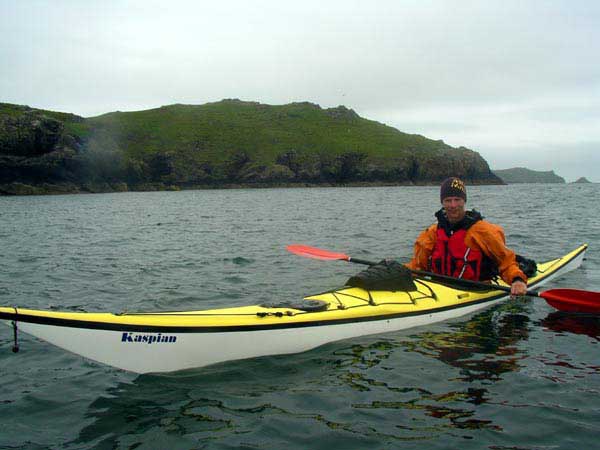SK18 Expedition kayak
HV17 Touring sea kayak
Shoreham Sea Kayaks are a new entry in the burgeoning UK sea kayak market, based – as the name suggests - on the Sussex coast. Their boats are constructed in Europe specifically for the company and their range includes three different hull designs with many optional variations. SSK aim to provide boats of high quality build and performance but – and here is their marketing ‘hook’ – to offer them at prices significantly below the established competitors. We were supplied two of their designs to test; the Kaspian SK18 and Kaspian HV17. The internet knows everything, so we Googled ‘Kaspian’. It turns out that the word means either a Central Asian sea, or a character in the ‘Narnia’ children’s books. Whatever. What we know for sure, is that the SK18 is designed as an out-and-out expedition boat to handle any conditions and get you from A to B fast, whilst the HV17 is also designed as a fast boat, only with much more volume and stability. A first glance reveals that the two boats are very different beasts. The SK18 is narrow and sleek and has graceful curve along its length. The back deck is a little lower than the front. The hull tapers to a thinly pointed bow which scores lots of points for aesthetics, whilst the hull narrows right down towards the stern. A retractable skeg offers directional stability and extra waterline length when needed. Two random passers-by asked if it was a ‘Nordkapp’ and although there are definite differences, the SK18 shares the appealing Inuit lines of this classic boat. By comparison, the HV17 looks far more functional and utilitarian. Although it is only 3 cm wider than its partner, it clearly has far more volume as the greater width is maintained along its length. It has a ramrod-straight hull profile with hardly any rocker (curve). This is extended as far forward and back as possible, to give a very long waterline, despite the HV17’s shorter overall length. At the stern this forms the equivalent of a fixed skeg. The bow still curves upward with some style and dignity, the HV17 isn’t ugly! The HV17 comes with a retractable rudder fitted as standard.
The HV17 in action The SK18 has three hatches sealing separate bulkheaded compartments, whilst the HV17 has just two. The dry storage capacity of the SK18 is 155 litres, whilst the bulkier HV17 can swallow 195 litres. In both boats there is loads of space in the cockpit in front of the paddler’s feet; our testers felt that they might prefer the front bulkhead fitted further back to increase the volume of the front compartment. The dry storage space in the SK18 is somewhat limited, given that the boat is designed for (and is otherwise appropriate for) true expedition use. For comparison, a Nordkapp has about 40 litres more storage. Best pack the dried food. The boats use quality Kajaksport rubber hatch covers, but they are not tied on; doing this yourself shouldn’t be too onerous and it is in ways like this that SSK have sought to shave pennies off the cost. Both boats have grab handles, decklines and deck elastics fitted. The decklines were simply tied off in a bow at the ends, allowing the buyer to fine-tune them to personal taste. The rudder on the HV17 is controlled by numerous confusing lines and elastics, and can be lifted out of the water whilst paddling. The deck features a padded ‘cradle’ to catch the rudder.
The SK18 off Pembrokshire Inside, the boats are kitted out somewhat frugally. Both feature seats which are adequate but reminiscent of those slidey seats in MacDonald’s designed to deter you from lingering too long over your milkshake. A buyer would certainly pad them out further for comfort, or even remove and replace them…they can be unscrewed easily. The backrests are minimalist and not especially comfortable; another easily upgradeable feature. The test boats had ‘Wilderness system’ footrests, again a minimalist solution; we found them a bit small for comfort and inclined to wiggle up and down irritatingly. Werner footbraces are available as an upgrade. Many may prefer to add a bar footrest or foam block, however…the pedal footrests make it awkward to paddle long distances with knees up for comfort. Neither boat features thigh braces, although the SK18’s cockpit shape allows easy knee control. Whilst SSK have not skimped on the build or performance of their boats, the interiors reveal where costs have been saved. Any paddler intending on making serious use of the boats will want to arm themselves with Karrimat and Evostick and devote an evening or two to fitting out the cockpits for better comfort and control. The Kaspians were thoroughly tested in a wide range of locations and conditions, which were often demanding…it was winter, for Heaven’s sake! They were used for both day trips and overnight expeditions, on tidal rivers, harbours, exposed coasts, open crossings, tide races and in surf. Weather conditions ranged from unseasonable sunshine and calm, to freezing cold near-gale. How did the two boats perform? The short answer is, perfectly fine. If this hadn’t been the case, at least one of our testers would not be with us to offer feedback! The SK18 is deceptive…it looks like a tippy nightmare, only to be braved when loaded down with a year’s supply of wine gums in the hatches. However, it really isn’t an especially unstable boat. For a boat narrower than your shoulders, it is remarkably unstressful to balance, even completely unloaded. Bouncing up and down through a mile-long tide race, one tester was able to open and chug down a bottle of Lucozade…he definitely kept one hand on his paddles though! The boat is obviously fast and skootles along with the minimum of effort. Turning is again surprisingly easy, although you may need more than a sixpence. The rocker along the hull makes this a sensitive craft; edging the boat over slightly to the side initiates quick course adjustments. Paddlers not confident to edge the boat will struggle with turning the SK18 and may wish to have the optional rudder added; although perhaps this isn’t the right craft for them anyway. The SK18 surfs pretty comfortably, and with judicious application of the skeg it handles well in a ‘quartering sea’…in plain speak, when you get that irritating wind and swell coming at you from behind and to the side. To summarise, a great performer. The blurb about the SK18 which came from SSK declared that, “In the right hands, it has the ability to take you practically anywhere”. We see no reason to disagree. The HV17 is aimed at paddlers wanting a higher and drier ride with much more stability and carrying capacity. Larger paddlers may appreciate the oodles of space in the cockpit. The long waterline demonstrates that it is not meant to compromise on speed. With almost no rocker, all of your paddling effort is funnelled into going forward, in a very straight line…this isn’t the boat for those who want to constantly divert course and check out every little rock and cave! The rudder is optional but we found that turning the HV17 without it expended a lot of effort. The HV17 also made for a pretty physical paddle whilst surfing downwind with the rudder up on deck; the ‘fixed skeg’ stern and lack of rocker meant that the boat was inclined to put up a fight! With the rudder down, life was much simpler and the HV17 steamed ahead on course. It all depends how you feel about rudders, but in the case of the HV17 the rudder made complete sense. Overall, the HV17 is ideal for a paddler who wants to clock up mileage on long trips, but doesn’t want to commit to a ‘lively’ high performance craft like the SK18. It’s also available in the enticingly named ‘HV17LC’ option, with three hatches and more cockpit space. As a postscript, the HV17 had an opportunity to prove itself rather more than the testers had intended…one short evening trip didn’t quite work out as planned. We now know for sure that the HV17 can confidently handle large following seas and strong winds, whilst towing another kayak in the middle of the night in pitch darkness. Don’t try this at home, children. Now the bit you’ve all been waiting for…the price. The SK18 costs just £1199, or to put it in context…£400 cheaper than a Valley Nordkapp or a P&H Quest. The HV17 goes for even cheaper at £1049. Obviously enough, this is extremely competitive pricing! The testers felt that the savings on cost were discernable enough in terms of the outfitting, which can of course by customised and upgraded after purchase. We found nothing at all to suggest that any corners had been cut in the construction quality of the boats, as one would hope. But before you rush to Shoreham’s cost-cuttingly sparse test-base to inspect or test-paddle one of these boats for yourself, be aware that they are not the only distributors of budget composite sea kayaks. Their competitors include Point 65 North and Island Kayaks, for instance. Clearly the market is expanding and this can only be good for sea kayakers. Not so long ago, the entry routes into the sport were to buy plastic, or to hunt down a seaworthy second (or third) hand boat. Companies like SSK have placed top notch 5 metre-plus expedition kayaks like the SK18 in a price bracket not a million miles away from that of sub-2 metre playboats! Expect to see more and more paddlers out on the sea in the coming years, and don’t be too surprised if many of their boats hail from Sussex. More info – www.shorehamseakayaks.co.uk Go back
to the Almanac / Reviews page |





